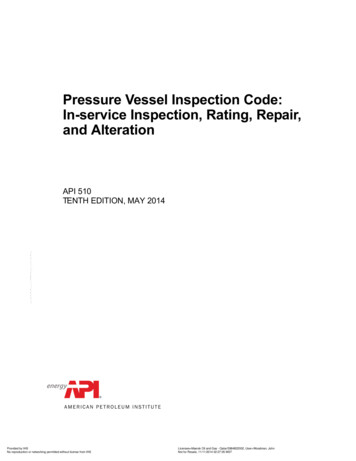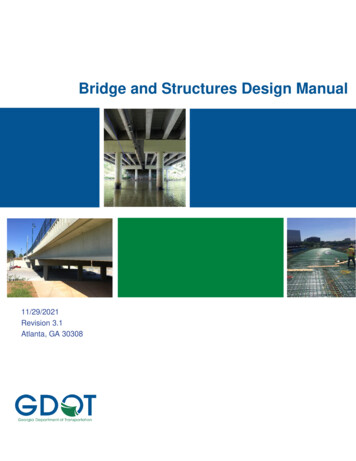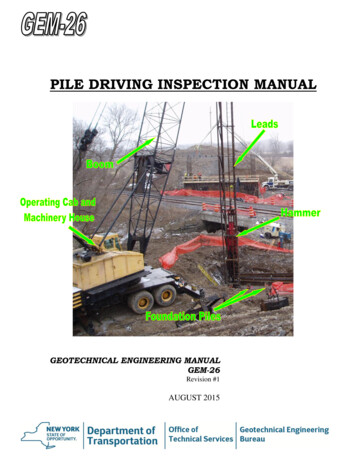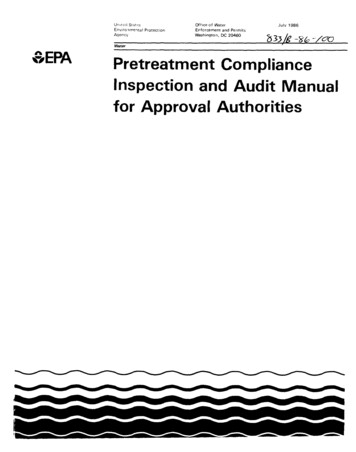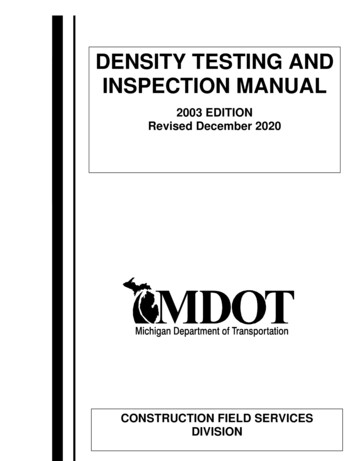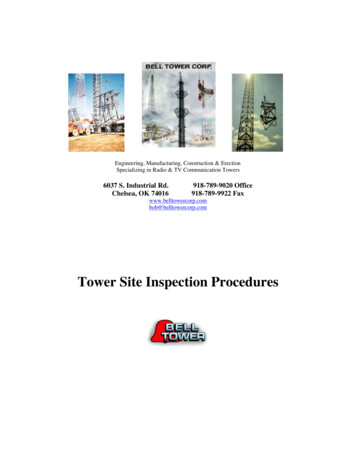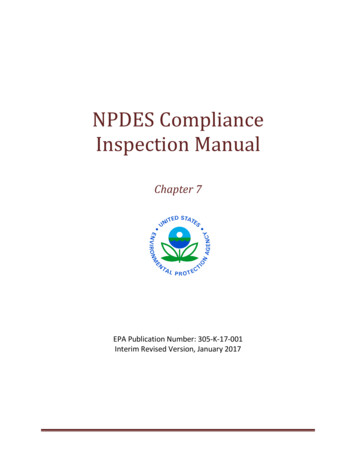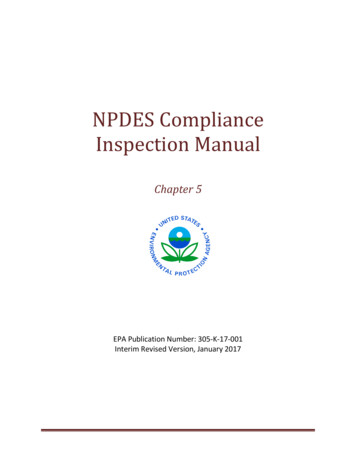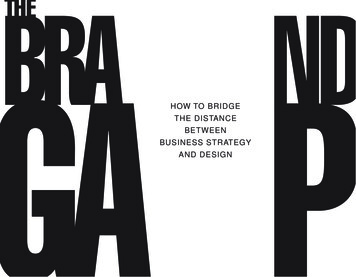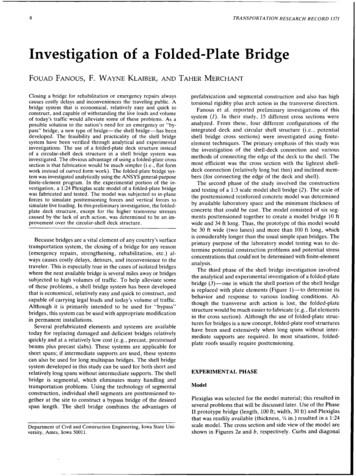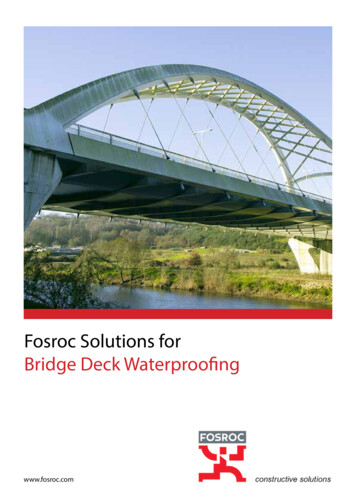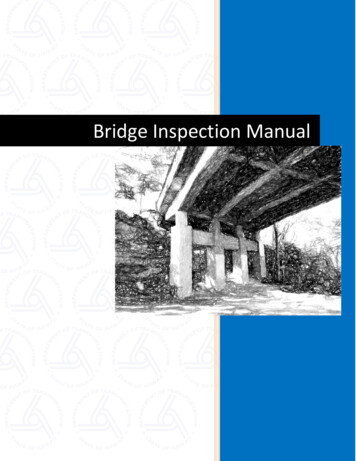
Transcription
Bridge Inspection Manual
Table of ContentsTable of Contents ---------------------- --------------------------------- 52.0BRIDGE INSPECTION PROGRAM ---------------------------------------- 3.42.3.52.3.62.3.72.3.82.3.92.3.102.3.11Purpose ----------------------------------------- 5Using BIP Manual & BrM ------------------ 5Definitions and --------------------------- 6Standards and Regulatory Documents ------------------------------------------------ 8Bridge Inspections Reference Documents ---------------------------------------------- 9Tunnel Inspections Reference ----- 9Organization --------------------------------- 10Statewide Program Directory ---------- 11Roles and Responsibilities ------------- 12Owner Responsibilities ------------------- 12Statewide Bridge Asset Management Program (BAMP) Manager: (currently ------------------------------------------------- 12Statewide BIP Manager: ----------------- 13Statewide Bridge Design Engineer: --- 14Statewide Load Rating Engineer: ------ 14Statewide Hydraulic Design Engineer: ------------------------------------------------- 15Statewide BrM Manager: ----------------- 15BIP Leader (BIP Lead): ------------------- 15Team Lead Inspector (Team Leader or Team Lead): ------------------------------- 17Underwater Inspection Diver (UW Diver): --------------------------------------------- 19Specialty Contractors --------------------- 193.0BRIDGE and TUNNEL INVENTORY and CODING-------------------- 214.0INSPECTION REPORTS ---- 1.34.1.4Bridge & Tunnel Number & -------- 21Rehabilitation, Strengthening, or Widening Existing Structures ----------------- 21Bridge and Tunnel Names -------------- 22Inspection Frequency -------------------- 22Reducing Inspection Intervals ---------- 22Late Inspections ---------------------------- 23Latitude & Longitude --------------------- 23NBI Item 113 – Scour Critical Bridge Coding (Scour Coding) ---------------- 23NBI & NTI Data Submittal to FHWA -- 24Report Contents and Format ---------- 26Report Cover Sheet ----------------------- 26Vicinity Map ---------------------------------- 26Table of Contents (TOC) ----------------- 26Inspection Summary ---------------------- 26Highways DivisionDepartment of TransportationState of HawaiiClick here to return to TOCPage 2Pub DateRev Date9/01/20203/15/2021
.5Load Rating Summary (LRS) ----------- 27BrM Element and SI&A Reports ------- 27Report ------------------------------------- 27Plan Sheets ---------------------------------- 28BrM Data and --------------------------- 28Traffic Safety Features ---------------- 29NBI Condition Ratings Notes ----------- 29Coding Report Type, Date, & Frequency ---------------------------------------------- 29Other Features Notes --------------------- 31Proposed and/or Recommended Work ------------------------------------------------ 32INSPECTION and REPORT TYPES --------------------------------------- 33General Inspection Criteria ------------- 33Inspection Methods and Drones ------- 33Inspection Process Diagram ------------ 33Initial Inventory ----------------------------- 35Routine Inspection ------------------------ 36Routine Inspection During Construction ----------------------------------------------- 36Routine Inspection for Scour ------------ 39Re-Load Rating during Inspection ----- 44Posting & Pictures ------------------------- 44Repair Recommendations --------------- 45Underwater (UW) Inspections --------- 47UW Level of Effort ------------------------- 47UW Requirements: ------------------------ 48UW Reporting ------------------------------- 48Fracture Critical (FC) Inspection ----- 49FC Member Procedures (FCP) --------- 50FC Reporting -------------------------------- 50Damage Inspection (DAM) -------------- 50Damage Inspection ------------------ 50Damage Inspection ------------------------ 50Damage ----------------------------------- 51Monitor Inspection (MON) -------------- 52Monitor Report ------------------------------ 52Post Event Inspection -------------- 52Post Event Report ------------------------- 53In-Depth Inspection (DEPTH) ---------- 53In-Depth Report ---------------------------- 53Tunnel Inspection (TUN) ---------------- 54NTI Data and ---------------------------- 54Coding Report Type, Date, & Frequency ---------------------------------------------- 55Proposed and/or Recommended Work (TBD) --------------------------------------- 56General Inspection Criteria and --- 56General Tunnel Inspection Practices - 57Highways DivisionDepartment of TransportationState of HawaiiClick here to return to TOCPage 3Pub DateRev Date9/01/20203/15/2021
5.10.65.115.11.15.11.25.11.3Tunnel Special Procedures (TSPs) --- 57Critical Finding (CF) ---------------------- 58Critical Finding Notification -------------- 58Critical Find Repairs ----------------------- 59Critical Finding Monthly Status Report ------------------------------------------------- 596.0BRIDGE FILE & REPORT DEADLINES ---------------------------------- 607.0BIP LEADER DUTIES & REPORT QC ------------------------------------ 668.0LOAD RATING & POSTING ------------------------------------------------- 739.0SCOUR EVALUATION REPORTS & POAS ----------------------------- 19.29.3Bridge File Document Name Format -------------------------------------------------- 60Document IDs ------------------------------- 61Document ID Descriptions (Alphabetical) --------------------------------------------- 62Finalizing Reports & Bridge File Submittal ----------------------------------------- 62Final Report Timeline & Deadlines ---- 62Inspector Qualifications Monitoring -------------------------------------------------- 66QC Review Checklist for Reports ---- 67Unscheduled Inspections --------------- 68Structures Discovered to Exist --------- 68Completed Construction and Temporary Structures ------------------------------- 68Initiating Damage Inspection by BIP Lead -------------------------------------------- 69Inspections Past Due --------------------- 70Plan of Action for Scour (POAS & POAC) ------------------------------------------- 70Monitoring Bridges for Flood Events -- 70Monitoring the Structures ---------------- 71Storm Reporting ---------------------------- 72Programming BIP Repairs -------------- 72Load Ratings -------------------------------- 73LRFR Load Rating Factor Less than 1.0 --------------------------------------------- 73Load Ratings Less than 0.5 ------------- 74After the Structure is Posted ------------ 74Concrete Bridges with Unknown Plans: --------------------------------------------- 74Load Rating Bridges with unknown Plans. -------------------------------------------- 74Scour Evaluation --------------------------- 76HEC-18 Analysis --------------------------- 76Requirements of a Plan of Action for Scour: -------------------------------------- 76Scour Evaluation Report ------------- 7710.0 STATEWIDE BRIDGE INSPECTION QUALITY ASSURANCE:---- 7910.110.210.3Procedures ----------------------------------- 79Roles and Responsibilities ------------- 80Metric Assessment Report (MAR) --- 8011.0 BRIDGE INSPECTIONS AND ITS ROLE IN THE TAMP ------------- 81Highways DivisionDepartment of TransportationState of HawaiiClick here to return to TOCPage 4Pub DateRev Date9/01/20203/15/2021
1.0INTRODUCTIONThe State of Hawaii Department of Transportation (HDOT) Bridge Inspection Program (BIP) wasestablished in response to the National Bridge Inspection Standards (NBIS) published in the U.S.Code of Federal Regulations 23 CFR 650, Subpart C and National Tunnel Inspection Standards(NTIS) published in 23 CFR 650, Subpart E.The NBIS and NTIS sets the national standard for proper safety inspection and evaluation ofbridges, reportable structures and highway tunnels on all public roads and requires that each Statetransportation department must include an inspection organization for bridges and tunnels that isresponsible for the following:a. Statewide inspection policies and procedures, quality assurance, quality control, and preparationand maintenance of the inventory of structures, except for bridges and tunnels that are owned byFederal Agencies.b. Structure Inspections, reports, load ratings and other requirements of these standards.c. The functions identified above may be delegated, but such delegation does not relieve theHDOT of any of its responsibilities under Subpart C or Subpart E.1.1PurposeThis BIP Manual was developed to provide context of how the Inspection process relates to theStatewide Transportation Asset Management Program (TAMP), as well as provides guidelines,policy, and procedures to ensure compliance with federal regulations CFR 650 Subpart C andCFR 650 Subpart E, respectively the National Bridge Inspection Standards and the NationalTunnel Inspection Standards. Unless a Local Public Agency (LPA) develops its own BIP Manual orpolicies that are approved by HDOT and FHWA, LPAs are to adhere to the procedures within thisdocument.Each State must prepare and maintain an inventory of all bridges subject to the NBIS, and tunnelssubject to the National Tunnel Inspection Standards (NTIS), in accordance with CFR 650. Theinventory includes the data needed for the Bridge Inspection Program and Bridge AssetManagement Program (BAMP) to function and to comply with the FHWA requirements. This dataincludes Structure Inventory and Appraisal (SI&A) data and Element data stored in HDOT’s BridgeManagement database (BrM) with information submitted to FHWA annually.This manual is not an engineering textbook or primer on the fundamentals of bridge inspection,instead the purpose of this BIP Manual is to assure that the bridge and tunnel inspections arebeing conducted in accordance with the requisite standards and to assure the quality of inspectiondata being presented for programming into the TAMP goals and life cycle preventive maintenanceof the Assets.1.2Using BIP Manual & BrMNew BrM users need to request a UserID and Password from brm.help@ hawaii.gov to accessBrM at https://brm.hawaii.gov/. Help for using BrM is available from the AASHTOware website andHighways DivisionDepartment of TransportationState of HawaiiClick here to return to TOCPage 5Pub DateRev Date9/01/20203/15/2021
can be accessed in the upper left-hand corner of any screen in BrM by clicking on the Logo.The most current version of the Bridge Inspection Program (BIP) Manual is on the HDOT website.Suggested edits or errors should be emailed with a recommended correction to the StatewideBridge Asset Program Manager (BAMP). Text changes to the BIP Manual will be highlighted in redtext and will indicate the Revision Date (Rev Date) in red text below the Publication Date (PubDate) at the bottom of the page.All links in the BIP Manual are provided as a convenience to the reader, but may not be up to date.1.3Definitions and TermsDefinitions used within this manual can be found in CFR 650. Subpart C contains terms related tobridges and Subpart E contains terms related to tunnels. Definitions from CFR 650 that arerepeated here may be paraphrased or quoted directly from CFR 650. Other terms are provided forclarity and may be specific to this BIP Manual for the State of Hawaii Department ofTransportation.Bridge is defined in CFR 650.305 as, “A structure including supports erected over a depression oran obstruction, such as water, highway, or railway, and having a track or passageway for carryingtraffic or other moving loads, and having an opening measured along the center of the roadway ofmore than 20 feet between under copings of abutments or spring lines of arches, or extreme endsof openings for multiple boxes; it may also include multiple pipes, where the clear distancebetween openings is less than half of the smaller contiguous opening”When used in this manual the term “bridge” includes all reportable structures which includebridges, culverts and tunnels unless stated otherwise.Bridge Inspection Experience is defined as active participation in bridge inspections inaccordance with the NBIS, in either a field inspection, supervisory, or management role. Acombination of bridge design, bridge maintenance, bridge construction and bridge inspectionexperience, with the predominant amount in bridge inspection, is acceptable. The NationalHighway Institute training may be found at the following URL:https://www.nhi.fhwa.dot.gov/home.aspxBIP is the abbreviation for Bridge Inspection Program.Bridge ID number is a unique number as defined in National Bridge Inventory (NBI) Item 008Structure Number in the FHWA Recording and Coding Guide.Bridge File is a file containing historic and current information about a bridge as required per CFR650.313(d) and containing the necessary information in Chapter 2 of the (American Association ofState Highway and Transportation Officials (AASHTO) Manual for Bridge Evaluation (MBE).Bridge Preservation is defined by FHWA as Actions or Strategies that prevent, delay, or reducedeterioration of bridges or bridge elements; restore the function of existing bridges; keep bridges ingood condition; and extend their useful life. Preservation actions may be preventative, or conditiondriven.Highways DivisionDepartment of TransportationState of HawaiiClick here to return to TOCPage 6Pub DateRev Date9/01/20203/15/2021
23 CFR 650 is used as an abbreviation for the term “Code of Federal Regulations - Title 23”. TheCode of Federal Regulations (CFR) is a codification of the general and permanent rules publishedin the Federal Register by the departments and agencies of the Federal Government. Title 23 isthe section designated for Highways, while Section 650 is designated for Bridges.Certification Date is the date personnel were qualified to perform BIP tasks.Complex Bridge is a movable, suspension, cable stayed, and other bridges with unusualcharacteristics.Critical Finding (CF) is defined in Critical Find Reporting Section of the BIP.HDOT is the abbreviation for Hawaii Department of Transportation.Inspections is defined in the Inspection and Report Types Section of the BIP.Local Public Agency (LPA) within the state of Hawaii that own and/or are responsible forroadway bridge structures include County of Kauai, City and County of Honolulu, County of Maui,and the County of Hawaii. Other LPA that do not own and/or are responsible for transportationinfrastructure include the Oahu Metropolitan Planning Organization, and the Maui MetropolitanPlanning Organization.The AASHTO Manual for Bridge Evaluation (MBE) provides guidelines for the procedures andpolicies for determining the physical condition, maintenance needs, and load capacity of highwaybridges. It was developed to assist bridge owners by establishing inspection procedures andevaluation practices that meet the National Bridge Inspection Standards (NBIS)National Tunnel Inventory (NTI) is the aggregation of structure inventory and appraisal data collectedto fulfill the requirements of the National Tunnel Inspection Standards. Each State shall prepare andmaintain an inventory of all tunnels subject to the NTIS.National Tunnel Inspection Standards (NTIS) are the Federal regulations establishing requirementsfor inspection procedures, frequency of inspections, qualification of personnel, inspection reports, andpreparation and maintenance of a State tunnel inventory. The NTIS apply to all structures defined astunnels located on all public roads.Non-Reportable Structure is a structure that is not required to be included in the annual NBI orNTI data submittal but may be included and managed in the BrM database. Examples includepedestrian bridges, privately owned structures, culverts and bridges less than 20 feet.Owner is defined as a person or entity who has the legal or rightful title and is held responsible bythe law as the owner of the property.Portal The term “portal” means the entrance and exit of the tunnel exposed to the environment; portalsmay include bare rock, constructed tunnel entrance structures, or buildings.Quality Assurance (QA) The use of sampling and other measures to assure the adequacy ofquality control procedures in order to verity or measure the quality level of the entire bridgeinspection and load rating program.Quality Control (QC) Procedures that are intended to maintain the quality of a bridge inspectionHighways DivisionDepartment of TransportationState of HawaiiClick here to return to TOCPage 7Pub DateRev Date9/01/20203/15/2021
and load rating at or above a specific level.Scour is erosion of streambed or bank material due to flowing water; often considered as beinglocalized around piers and abutments of a structure.Scour Countermeasure: Defined here as a scour feature placed during construction of a newbridge or added to an existing bridge that is designed and constructed to mitigate scour inaccordance with the current Hydraulic Engineering Circular (HEC-23) requirements. See ScourRepair.Scour Critical Bridge is a bridge with an NBI Item No. 113 Scour Critical Bridges coding of 3, 2,1, or 0 because of a foundation element that has been determined to be unstable for the observedor evaluated scour condition.Scour Repair is defined here as a scour repair or feature that is not designed to meet HydraulicEngineering Circular (HEC-23) requirements.Shall is applied in this Manual to mean the same as must. Must is a regulatory or legal term andmeans that conformance is required and mandatory without exception.Specification for the National Tunnel Inventory (SNTI) provides the recording and codingspecifications for tunnel information to be entered into the NTI.Structure is defined as a bridge, culvert or tunnel unless specified otherwise.Statewide Transportation Asset Management Plan (TAMP) – The Statewide TransportationAsset Management Plan was prepared on June 30, 2019 as required by the FAST Act, describesthe processes and formally defines HDOT’s framework for asset management.Tunnel The term “tunnel” means an enclosed roadway for motor vehicle traffic with vehicle accesslimited to portals, regardless of type of structure or method of construction, that requires, based on theowner’s determination, special design considerations that may include lighting, ventilation, fireprotection systems, and emergency egress capacity. The term “tunnel” does not include bridges orculverts inspected under the National Bridge Inspection Standards (23 CFR 650 Subpart C).Under Bridge Inspection Truck (UBIT) A truck (aka snooper truck or reach-all) with a bucketused to access elements under a bridge deck.1.4Standards and Regulatory DocumentsAll inspections and reports for bridges and tunnels must be in accordance of the following list ofapplicable standards, regulations & references. The current version or edition is applicable,including subsequent revisions, interims or errata unless stated otherwise. The current version forinspection contracts is the active version on the date the contract is awarded. The list indicatesthe Document Order of Precedence for inspections and a basis to resolve conflicts. Please notifythe Statewide BIP Manager when there is unresolved or conflicting information.The signs for bridges and tunnels must comply with the Manual on Uniform Traffic Control Devicesor MUTCD.Highways DivisionDepartment of TransportationState of HawaiiClick here to return to TOCPage 8Pub DateRev Date9/01/20203/15/2021
1.4.1 Bridge Inspections Reference Documents1. State of Hawaii Statewide Transportation Asset Management Plan (TAMP)2. “FHWA Recording and Coding Guide” - FHWA Recording and Coding Guide for the StructureInventory and Appraisal of the Nation’s Bridges, FHWA Report No. PD-96-001December 1995.3. FHWA Memo, “Revision of Coding Guide, Item 113 - Scour Critical Bridges”, April 2001.4. AASHTO Manual for Bridge Evaluation (MBE); incorporated by reference in 23 CFR 650.317.5. Bridge Inspector’s Reference Manual (BIRM), FHWA NHI 12-0496. HDOT Design Criteria for Bridges and Structures7. HDOT Design Criteria for Highway Drainage8. Inspection of Fracture Critical Bridge Members, FHWA Report No. IP-86-26, September 1986.9. FHWA Technical Advisory T 5140.23, Evaluating Scour at Bridges, dated October 28, 1991.10. HEC 18 Evaluating Scour at Bridges, FHWA-HIF-12-003, 2016.11. HEC 20 Stream Stability at Highway Structures, FHWA-HIF-12-004, 2012.12. HEC 23 Bridge Scour and Stream Instability Countermeasures, Volume 1 (FHWA-HNI-09-111,2009) & Volume 2 (FHWA-HNI-09-112, 2009).13. HEC 25 Highways in the Coastal Environment, Volume 1 (FHWA-HNI-14-006, 2014) andVolume 2 (FHWA-HNI-07-096, 2008)14. 2D Hydraulic Modeling for Highways in the River Environment, FHWA-HIF-19-061, 2019.15. FHWA Memorandum "Scourability of Rock Formations," dated July 19, 1991.16. Underwater Bridge Inspection, FHWA-NHI-10-079, 201017. ASCE Underwater Investigations: Standard Practice Manual, 200118. FHWA Questions and Answers on the National Bridge Inspection Standards CFR 650 SubpartC (FHWA Q&A).1.4.2Tunnel Inspections Reference Documents1. Tunnel Operations Maintenance Inspection and Evaluation (TOMIE) Manual, FHWA-HIF-15005, July 2015.2. National Tunnel Inspection Standards (NTIS), 23 CFR 650, Subpart E3. Specifications for the National Tunnel Inventory (SNTI)Highways DivisionDepartment of TransportationState of HawaiiClick here to return to TOCPage 9Pub DateRev Date9/01/20203/15/2021
2.0BRIDGE INSPECTION PROGRAM2.1OrganizationPer 23 CFR 650.307(a), “each State transportation department must inspect or cause to beinspected, all highway bridges located on public roads that are fully or partially located within theState’s boundaries, except for bridges that are owned by Federal agencies.” HDOT’s StatewideBridge Inspection Program (BIP) Manager administers this program as described below on theorganizational chart and in Section 2.3, Roles and Responsibilities.HDOT BIP Leaders are responsible for oversight and support of the LPA offices within the HDOTDistrict. An LPA not in compliance could result in the suspension of Federal-Aid highways fundingto HDOT until compliance is met.The remainder of this page is intentionally left blankHighways DivisionDepartment of TransportationState of HawaiiClick here to return to TOCPage 10Pub DateRev Date9/01/20203/15/2021
2.2Statewide Program DirectoryPOSITION TITLEStatewide Bridge AssetManagement Program (BAMP)ManagerStatewide Bridge DesignEngineerStatewide BrM CoordinatorStatewide Load RatingEngineerStatewide Hydraulic DesignEngineerStatewide MaintenanceEngineerStatewide BIP ManagerHawaii District BIP LeaderHawaii Co BIP LeaderKauai District BIP LeaderKauai Co. BIP LeaderMaui District BIP Leader:Maui Co. BIP LeaderOahu District BIP LeaderOahu C&CH BIP LeaderOFFICE LOCATIONBridge Design Section(HWY-DB)Bridge Design Section(HWY-DB)Bridge Design Section(HWY-DB)Hydraulic Design Section(HWY-DH)Maintenance Section(HWY-CM)Maintenance Section(HWY-CM)HWY Hawaii District Office(HWY-H)Hawaii CountyHWY Kauai District Office(HWY-KE)Kauai CountyHWY Maui District Office(HWY-MD)Maui CountyHWY Oahu District Office(HWY-OM)City & County of HonoluluHighways DivisionDepartment of TransportationState of o@hawaii.govClick here to return to TOCPage 11Pub DateRev Date9/01/20203/15/2021
2.3Roles and Responsibilities2.3.1 Owner ResponsibilitiesOwner (as specified in NBI Item 21 – Maintenance Responsibility), is defined as the individual oragency that legally owns the asset. BIP Leads represent each HDOT/HWY District and LPA in theBridge Inspection Program and works within the Owner Agency to accomplish the necessaryprogram activities. For instance, the Department of Land and Natural Resources (DLNR) may ownthe asset and the HWY district has responsibility to inspect and maintain the asset.Non-NBI Structures:Owners may want to track or be aware of structures that do not meet the definitions contained inthe NBIS or SNTI such as: Pedestrian bridges, privately owned bridges, or Structures 20 feet.These structures are not included in the National Inventories but may be included in the BrMdatabase at the Owners discretion. The Inspection Frequency is determined by the BIP Leader forthese structures and should not exceed 48 months for structures more than 5 feet. Initialinspections and coding these structures should follow the same criteria2.3.2 Statewide Bridge Asset Management Program (BAMP) Manager: (currently underdevelopment)Role: Bridge Asset Management is a core bridge discipline that focuses on making informed andeffective decisions on the operation, maintenance, preservation, replacement, and improvementon a program of bridges evaluating alternative strategies for addressing needs, and prioritizinginvestments, projects, a
Mar 15, 2021 · This manual is not an engineering textbook or primer on the fundamentals of bridge inspection, . combination of bridge design, bridge maintenance, bridge construction and bridge inspection experience, with the predominant amount in
